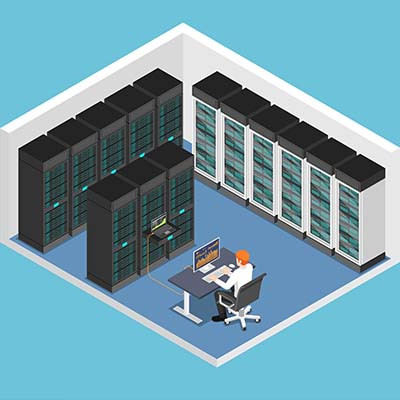There are all kinds of different file formats for just about anything stored on your computer, but there are a couple of images that you might not immediately be able to tell the difference between. Depending on how the picture is used, the file format can make all the difference. Let’s investigate some of these image file types and what they are best used for. Doing so may help you make better decisions as you go about your daily tasks.
k_Street Consulting, LLC Blog
The Internet of Things—the IoT—is very much a double-edged sword, insofar as it can create some very real threats just as easily as it can offer businesses considerable benefits when leveraged properly. Let’s focus on this latter point and explore the kinds of benefits that the IoT can bring to the workplace.
When dealing with business computing, there are many situations where threats could potentially ruin the good thing you’ve got going. Today, a lot of businesses are getting much more serious about their IT security with what is known as a “zero-trust policy”. What exactly is a zero-trust policy? This month we will explain it.
Are you tired of hearing about the importance of secure passwords, two-factor authentication, and security updates?
We get it. All of these techno-nerds (ourselves included) have spent all of October and even the weeks leading up to it talking about the importance of cybersecurity, preaching the importance of things that, let’s face it, just get in the way of you getting work done. Thank goodness Cybersecurity Month is long over, and now we can all get back to being absolutely reckless with our data, right?
Businesses need to adjust their technology to meet their operational goals. Oftentimes, this can be the difference between loads of inefficiency and things going smoothly. Unfortunately, it isn’t always easy to ascertain where your business should spend its capital. Let’s take a look at how you can match your technology with your operational goals.
We live in an era of upgrades. Consider how often people upgrade their smartphone. Do you give the same care and attention to your business’ technology? Oftentimes users ignore the signs that it is time for an upgrade even when they are crystal clear, just saying to themselves, “I’ll get by just fine.”’ This is not the mentality that will help you move beyond your current productivity. You need to be able to identify when older devices are holding you back and take steps toward replacing them with better, more powerful ones.
Love it or hate it, remote work is here to stay—particularly now that many people have experienced it for themselves and have no intention of giving it up. However, many employers are going to want their employees back in the office to some degree. How can a balance be struck between these two sides? We posit that a hybrid work environment will play a role.
Do you know those horror stories you catch every so often where a huge business has their network hacked and millions of their customers and employees have their personal and financial information leaked onto the Dark Web? Your organization isn't likely as big as theirs, but regardless of how much money, people, and diverse revenue streams an organization has, having its network breached and its customers’, or its employees’, information strewn about over the Dark Web is not an ideal scenario.
Given the past few years and the assorted challenges that businesses have experienced during these tumultuous times, it is little wonder that businesses are seeking to alter their operations. Fortunately, today’s technology offers these opportunities to businesses, for prices that are surprisingly attainable for organizations of all sizes. Let’s discuss three such examples you could implement in your own business.
In today’s age of remote and hybrid operations, engaging your employees has never been more important. People want to feel like they belong, like they are connected to their coworkers and colleagues. What can you do to encourage this type of connectedness that might not always be so easy when your workforce is scattered about?
Cloud computing is turning into a tool that is universally used by businesses to enhance remote access and provide the scalability for tools that allows a business to get the best bang for their buck. This month, we’ll describe how modern cloud computing works and why it is such a huge potential benefit for your business.
For the business owner, when deciding what type of technology to invest in, one of the major considerations has to be when you are going to recoup the expense of that investment. No two technology investments are the same, and if you can’t get your money out of it (and then some), why even bother making the investment in the first place?
With more businesses than ever relying on their inventory to get through difficult times, it’s important to know just what resources you have at your disposal. Even if your business doesn’t produce goods or materials, it can be helpful to know what assets you have readily available at any given time. This is where inventory management comes in. Today, we want to give you a brief overview of inventory management and how technology can make it easier.
Let me ask you a question… if you were a hacker, how quickly would you take advantage of newly disclosed bugs and other vulnerabilities? I’d bet it would be pretty quick, and industry experts agree. According to these experts, there’s less and less time for security professionals to react to vulnerabilities and zero-day threats… and it continues to shrink.
So, the question remains, how prepared is your business to respond when these kinds of vulnerabilities are taken advantage of?
Your technology resources are likely deployed across your business and while all that IT can really help speed up your business and make it more effective, you also have to watch your technology spending so it doesn’t become a problem as you move your business forward. This month, we are going to get into how to deploy certain resources to help you save some money and at the same time get the technology you need to be more productive.
The pandemic has brought about a change in the way that businesses operate. While companies may have once been limited to getting work done in the workplace, there has been a shift in the opposite direction with many companies retaining remote employees or keeping certain remote workplace policies in place even now. What is the difference between remote and hybrid options, and how do you determine which is best for your company?
With cryptocurrency having its heyday over the past few years and the increased attention it has brought the blockchain, it should be no surprise that another trend has arisen. NFTs. or non-fungible tokens, have been all the rage as of late… but is this trend something that might apply to businesses?
Your servers run the technology that fuels your business. That’s why they are the most important (and expensive) pieces of hardware that you house. When it comes time to refresh one (or all) of your servers, you need to make a choice: Do you purchase a new server to host in-house or do you move your central computing to the cloud?
How do you look at your organization’s data? The answer will likely be the same as how you look at your organization. The businesses that do more to use their data to improve their business’ process, policies, and strategies, are the businesses that, by-in-large, are the ones that grow more rapidly and see more operational efficiency. This month, we thought we would look at four ways your business can use their data to actively improve its operations.
Cybersecurity is not easy to manage, and even professionals have their work cut out for them against modern threats like ransomware and other high-profile security threats. Today, we want to educate you on some of the terminology used in cybersecurity, namely the relationship between a vulnerability and an exploit, as well as what you can do to keep the risks associated with both relatively low.
One of the more overlooked parts of cybersecurity attacks involves social media and social engineering tactics targeting it. If you’re not careful, you could be putting yourself at risk of attacks through social media. How can you ensure that your staff members are keeping security at top of mind even when using social media? Let’s find out.
In order to produce the results that your business’ customers demand, it is essential that your team work together. This collaboration comes in several forms, but if one person struggles, it can be a dire development for any project or service delivery. This month we thought it would be useful to outline what effective collaboration looks like and give you some insights into how technology fuels most of your business’ collaborative efforts.
One of the best things about technology is that it does quite a bit to level the playing field. Smaller businesses can effectively do the work of larger enterprises because they have access to similar technologies. Additionally, technology goes a long way toward helping businesses manage their customer relationships, a key component to any revenue-seeking endeavor. This month we thought we would put together a list of four technologies every small business can use to manage their business and compete in their market.
No business can be successful without collaboration. As such, businesses invest heavily in tools which facilitate effective collaboration for their employees. Let’s take a look at some of the variables that can contribute to an effective collaboration strategy, as well as how you can promote collaboration in the workplace.
Your relationships with your customers and clients are reliant on one thing more than any other: communication. In order to optimize this communication, many businesses are leveraging technology solutions, and are enjoying a variety of operational benefits as a result. The question is: Is your business one of them?
Every organization depends on their information systems to be up and available when they need them. Some businesses simply can’t function at all without them. When a business inevitably needs to patch their software or perform other maintenance, it can cause problems when employees need these systems to be available. This month, we’ll talk about the strategy behind proactive IT maintenance and how it helps businesses avoid downtime in multiple ways.
Business communications, which is the succinct way to say the sharing of information between people both internal and external to a company, is a key player in that company’s success. Here, we’ll analyze the different types of communication that a business could leverage, and the solutions that best enable them.
With many people choosing to work remotely, and businesses more or less embracing the idea of employing mobile teams, the tools and strategies needed to keep your business’ data and infrastructure safe could be new to your business, but for the most part many of them are actions that any organization looking to secure their IT would take. Let’s take a look at some of the strategies used to secure remote endpoints.
Ransomware is an incredibly disruptive threat that can put your business at risk, but it is increasingly becoming not just a fiscal risk to organizations, but also to the physical health and wellbeing of communities and individuals. The Federal Bureau of Investigation has issued a warning that should have everyone concerned about the future of ransomware attacks, not just in business, but in everyday life.
It hasn’t been too long since connectivity required an actual physical connection between the connecting endpoints, making a wired connection the de-facto option for businesses. However, now that wireless connectivity is so widely available, businesses now have a choice… but which is the better option? Let’s compare some of the pros of each to make the answer a little clearer.
With the Internet of Things taking the world by storm, it’s no surprise that many businesses are attempting to leverage it to their advantage. However, implementing these devices into your operations comes with its fair share of risks and challenges. Let’s discuss some of the ways you should consider implementing the Internet of Things for your business, as well as what you must consider when building your IoT strategy.
For much of the past decade, data privacy has been a big issue. Ever since information was unveiled on how major tech companies (and other companies) use the information gleaned from their users, there has been a cross-section of people who have started to fight back against it. Unfortunately for Americans, this hasn’t resulted in an overarching data privacy law that protects people and their personal data. This month, we’ll take a look at the data privacy environment and discuss why there haven’t been any moves by U.S. lawmakers to protect data privacy.
Voice over Internet Protocol, or VoIP, is one service that just about any business can use to their advantage. It’s a fact that the traditional telephone systems used by companies for years have not aged particularly well, and VoIP offers them an alternative solution that is both dynamic and more flexible. Let’s dig into some of the benefits your company can find from a well-timed and well-planned switch to a VoIP solution.
Businesses have always attempted to optimize productivity for their employees in a variety of ways, but there are certain distractions that will always persist–especially in today’s incredibly connected world. One of these distractions is social media, and it creates the illusion of productivity when, in reality, it’s really not helping much.
When we tell you that it’s a best practice to implement complex passwords for your business, do you know what exactly a complex password is? The truth of the matter is that secure passwords are a little confusing, and the standards continue to shift back and forth. Let’s examine some of the industry-standard best practices for implementing secure passwords and how your organization can go about doing so.
Of any operational strategy, collaboration is both the simplest to set up and the most difficult to master. The organizations that do, stand to benefit greatly from the massive amount of efficiency that is created, and the productivity that results from it. The organizations that struggle with it,won’t be as efficient and that typically means costs will rise. Let’s take a look at some of the ways businesses can work toward collaborative mastery.
Companies hire many talented individuals for many different types of positions, but one way that some organizations choose to amplify their operations is through proper outsourcing. This practice can be invaluable for businesses that want to take things up a notch and adjust the way they operate for the better.
These days it can seem like the gap between small business and large enterprise is so massive that it is impossible to close, but the truth is the exact opposite. Through the smart application of business technology, you might be surprised by how much you can improve your operations and stand out from the crowd. It all boils down to tracking your business for analytics, ensuring that you provide an excellent service or experience to your customers, and implementing the right technology solutions.
In today’s business world that is so reliant on technology, there are few issues more disruptive than a computer that is not working properly. When your computer stops working and you have no clue what to do next, who is first on your calling list for assistance? Do you have someone on-hand who can resolve your technology problems?
Considering the circumstances of the past couple years, it’s no surprise that many businesses have turned their attention towards creating a long-term plan for a remote workforce. There are many considerations that must be brought front and center to create such a remote work policy, many of which require a focused examination of technology and the practices associated with it. Let’s take a closer look at what you might want to think about when crafting your remote work policies.
There are a lot of threats out on the Internet, and many of them have absolutely a slim chance to threaten your business. Unfortunately, there are plenty that can and it only takes one to set your business back. Many IT professionals currently working for enterprise businesses deal with threats day-in and day-out, so they are experienced and knowledgeable. Small business owners, who for all intents and purposes are the lead IT decision-makers, don’t always consider these risks; they just need to keep their business running effectively.
When it comes to your business, what do you prioritize? Do you focus more on security, or do you focus more on the business continuity side of things? The reality here is that both are of critical importance. Unfortunately, however, it seems that many executives feel like the current circumstances surrounding the ongoing COVID-19 pandemic have led them to prioritize one over the other.
You don’t need us to tell you that business owners have a lot of work to do, so you should make it a priority to streamline as much of this work as possible. You can use an easy four-step process to make your day-to-day tasks easier and more efficient, and who knows? You might even be able to free up some of that time by asking others to pitch in every now and then. Here are four tips you can use to get the most out of your productivity routine throughout the day.
Bad things happen. If your business fails to plan for the worst, when something terrible does happen, you could be looking at disaster. If you have a comprehensive continuity plan in place, however, you have a fighting chance. Let’s discuss some of the elements you absolutely need to address when making your business’ continuity plan.
There are some periods in history referred to as “great,” many of which were devastating in scope. We are currently living through a period that is becoming known as The Great Resignation. People are leaving their jobs in droves without having other employment opportunities lined up. As you can imagine, this is creating significant challenges for many businesses. Let’s take a closer look at what The Great Resignation really is and why it’s important to understand for a small business.
You might wonder how it is possible that people can guess the passwords of others, but it turns out that it’s a bit easier than you might at first think. According to a new study, not only has a significant portion of the population tried to guess someone else’s password, but even more of them are successful in doing so. How can this be, and what can we learn from this trend?
While reading our blog and newsletters, you might come across the word “encrypted” quite a lot. Sometimes it’s in the form of ransomware encrypting data, while other times it might be regarding the encryption of passwords within a password manager. Regardless, one thing is certain: encryption is an important part of the modern workplace.
Disaster recovery is one of those platforms that businesses don’t want to have to use, but need to spend ample time planning in case they do. This is rather unique in business, so only by truly understanding what you need to get out of your disaster recovery strategy can you create the comprehensive DR system that your business requires.
Every business has vendors and most of them take up more time than they probably should. Some of the relationships are pragmatic and fulfilling, but many take up too much time and effort and tend to distract decision makers from focusing on what is truly important within the business. As far as technology goes, depending on your company, you may have a dozen or more vendors contacting you sometimes a couple of times a month looking for you to expand your investment with their companies. Let’s talk about how vendor management can help your business.
For twenty years, hackers have tried to breach organizational networks by finding or breaking holes in the network’s perimeter, or in exposed servers. This led to the cybersecurity industry creating software designed specifically to stop these threat actors in the act. This, in essence, created a situation where the perimeter of an organization’s network was extremely hard to breach. The problem was that as soon as something was able to get through the outer defenses, there was no end to the devastation a hacker could cause inside a network.
The Internet is a wondrous place filled with countless resources and tools to be more effective in your day-to-day routine or business practices, but it is also home to a plethora of dangers that threaten the very existence of your organization. As an executive and business professional, it is your responsibility to identify opportunities to protect your company. One such way you can do so is by implementing a content filter.
More businesses than ever are using the cloud, and considering the fact that the world has been ravaged by a pandemic for well over the past year, it’s no wonder that this has happened. Still, well before COVID-19 flipped the workplace on its head, there was major change happening in the way companies utilized the cloud. All of this progress toward the cloud, however, has not diminished the importance or desire for on-site data centers. Let’s investigate this phenomenon.
You would be surprised what types of things can disrupt your business’ ability to operate. It could be something as benign as a power or Internet outage, something inevitable like a hardware component failure, or something so nefarious as ransomware. Regardless of what happens, every business should have a plan in place to respond to any situation and recover quickly and effectively. For the business that depends on data, having it properly backed up solves one major issue. This month, we thought we’d go over some of the basic questions you need to answer about your data backup and recovery process.
How does your business manage its IT resources? Do you have a chief information officer, or CIO, in-house who manages everything related to your technology? If not, who is the one responsible for managing and maintaining your systems? If you don’t know the answer to this question, we have a reality check for you: you need to.
Technology support is a necessity for a business that wants to stay operational. To this end, a quality help desk is vital. Unfortunately, not all help desks have the same level of quality and knowledge on how to best support your business. We’ve put together a list of traits that you should look for when it comes to finding the best help desk support for your business.
Businesses are always trying to be as productive as possible, but the truth of the matter is that productivity is not a constant state of getting things done. It is perfectly natural to have ups and downs throughout the week that ultimately contribute to any progress made on tasks. The question then becomes one of how can you make progress toward goals for the workday. Here are four tips that might help you get more done throughout your day-to-day duties.
There is a misconception going around that the absolute only way you can possibly take care of your organization’s technology is to hire dedicated professionals to monitor and maintain every aspect of it. There is considerable benefit to doing this, we won’t lie, but there is value in applying specific mantras from everyday life to your IT infrastructure. With these small, common-sense practices, you might see some long-term success in IT management even without professionals at the helm.
Access control can be a touchy subject for some employees, especially for those who might feel they can do their jobs more effectively if they were to be given access to certain files or sensitive information. That said, in the interest of network security and data protection, it is your responsibility to consider who amongst your staff has access to certain information and why.
Securing your digital platforms has to be a major point of emphasis for every business. For years, having a password was enough to keep unauthorized entities out of secured accounts. Those days are effectively over. With threats multiplying and getting more and more dangerous, companies have to do more to secure their IT. This month, we thought we’d take a look at some of the best practices in creating passwords and alternatives that can help you better protect your business’ technology.
Many businesses have started to limit the amount of printing they do, but some companies simply can’t. If your business relies on its printers and copiers, it can be a real challenge to find a reliable and knowledgeable maintenance provider. Sure, you can rely on the support provided by the manufacturer, but you may find that middling, to be kind. This month, we thought we would provide a few tips on what to look for in a printer/copier maintenance company.
Business is all about making the most of the time that you have available to you, and while some employees are great at doing such a thing, others might have silent roadblocks that eat up minutes or potentially even hours of their days. Yes, downtime is a very real threat for businesses, and while some employers are more concerned with nickel-and-diming employees for the short amounts of time they spend in between tasks, real true downtime is much greater of an issue.
If anything has been made clear by recent strings of high-profile ransomware attacks, it is that businesses and organizations simply do not take security as seriously as they need to. We urge you to use this opportunity to reconsider your own levels of network security. Are you doing all that you can to keep your data and assets secure? There are countless threats out there, and they all must be addressed (or at least prepared for) in some way.
Often smartphones are a double-edged sword for businesses: on one hand, they are a great money saver if an employee is willing to use their own for business purposes, but this does leave your business vulnerable in a few ways. Fortunately, if the benefits are something you can't function without, the vulnerabilities are simple enough to shore up with something called mobile device management.
We are consistently adamant that businesses have a comprehensive data backup strategy to help secure its operational continuity. The threat environment in which we find ourselves at the present time only reinforces the importance of such a backup strategy. This month we thought we’d take a few minutes to review what makes a business’ backup platform comprehensive.
Technology adoption can be a major issue for many businesses, mostly due to the variable costs of adding new technologies to a business’ cache of technology tools. For smaller businesses, adding new technologies that will allow them to compete with larger businesses can be even more difficult. Let’s take a look at the adoption gap between larger businesses and smaller businesses and why they are having a hard time closing it.
Business owners and managers are always looking to save capital, but it’s hard to do so as the cost of doing business continues to climb. This leads many decision makers to consider cloud-based tools when they are shopping for the best solutions to their business’ problems. The cloud offers several solutions to help the modern business keep their costs down, and one service that can be very valuable is Voice over Internet Protocol (VoIP). VoIP, specifically hosted VoIP, can help you reduce your communications costs in many ways, including:
Most companies have some sort of regulation they need to stay compliant to, and 2021 seems to be a landmark year. Over the past year, companies have had to deal with a growing remote workforce, end-of-life upgrades, the development of new privacy laws, as well as the existing regulatory landscape. Let’s take a look at why compliance is important for your business.
With vaccines for COVID-19 now being distributed around the whole world, small businesses who switched to remote work have a decision to make: should they continue allowing employees to operate remotely if they so choose? Let’s discuss the concept of a hybrid work environment and how businesses manage the still-changing situation.
For most businesses, technology is a complete necessity these days. It’s been proven that, by integrating some technology strategically, businesses can solve major operational problems that many smaller businesses and startups can’t. Today, we will ask three questions about business tech that any technology-savvy individual should know, and explain why you should know them.
Businesses spent a lot of time and money in 2020 adjusting to the COVID-19 pandemic. One could argue that many of them didn’t have a plan until it was to the point where either they made one, or their business collapsed. Some collapsed anyway. It has been a difficult year with businesses that have made it through doing the right things and using a set of new tools that allowed their operations to remain effective. Many of these tools will be phased out when the time comes, but one is absolutely here to stay: video conferencing.
Your business’ network is so important that if something were to infiltrate it that doesn’t belong there, it could wreak havoc on your whole company. One way that businesses can get their cybersecurity to a reliable place is through what is called penetration testing. This month, we thought we would briefly describe what exactly penetration testing is and how it can help your business.
Managed Services provide endless benefits to any business, no matter the size. Having a “Fix it when it breaks” attitude is an unrealistic way to run your business in an era that is so heavily technology-dependent. Today we dive into the many reasons a Managed Service Provider (MSP) can maximize your investment.
More businesses rely on their mobile strategies than ever before. For the most part, this uptick in mobility has helped sustain some business at a time when many would be expected to fail, but relying more on mobile definitely comes with some risks. This month we thought we would take a long look at mobility and how it can be a risky proposition for the modern small business.
Professional services run the world. As a result, it is imperative that they innovate with the times. It is increasingly important that professional services companies keep their finger on the pulse of new technology. Let’s take a look at some of the technology that can benefit professional services companies.
Backup strategies vary. Some companies choose theirs for its value. Some back up everything. Some ignore it all together. While we definitely don’t advise the latter, we do understand that it is a financial investment for what is essentially insurance. What’s more effective is building a backup plan that fits the type of data you create and store.
In the course of doing business everyone has their own specific responsibilities. One overarching responsibility that all employees need to have today is awareness. The health of a business depends on it. A staff’s failure to properly shoulder their load of security can have an immensely negative result for both the employee and the company. Today, we’re going to explain that when your organization gets breached by hackers, that fault is largely yours.
Businesses of all kinds depend on the technology that they use, whether it’s their email, a CRM, or just a single PC with a spreadsheet program. Those businesses that keep it real simple, have to know that there is technology out there that can help them bring in more revenue streams or properly manage the ones they already have. Those that look to technology to solve their business’ operational woes, tend to have several options to choose from. One thing is certain, if you have proper counsel when making technology decisions for your business, your chances of spending your capital wisely increase substantially.
Finding ways to save money is something that most entrepreneurs take pride in. Today, as costs of doing business continue to climb, VoIP can present the business owner with the rare solution that actually saves them money. Hosted VoIP, in particular—where your phone system is hosted in the cloud—presents an innovative and straightforward way to reduce your business’ operational costs. Let’s take a look at some ways it goes about doing this.
Novelty holidays have been all the rage for the past couple years. The thing is that if you are going to celebrate World Kimchi Day on November 22 or its sister holiday, World Cabbage Day on February 17, you either really like cabbage, or you really like holidays. With so many people using technology as a major part of their life and business, it’s no surprise that it is well represented on the holiday calendar. You have a few we’ve already missed: National Technology Day on January 6, Data Privacy Day on January 28, and National Clean Out Your Computer Day on February 8, but there are three important IT “holidays” this month. Let’s take a look at them now.
With cloud computing being utilized by a majority of businesses nowadays, it’s not as big of a surprise when one wants to move files from a locally-hosted server to a cloud server; or, from a cloud server to a new cloud server. This presents a fair amount of problems that you have to be mindful of if you want to move the data and applications over properly. Today, we’ll take a look at some problems you may face, and how to make sure they don’t weigh down your next cloud migration.
A business that has workers that are above average at maintaining productivity is typically a successful business. There are an endless number of suggestions on how to be and remain productive, and how to sustain that productivity. One thing that isn’t typically mentioned in all of that self-help advice is the role that patience plays in productivity. This month we thought we would do just that.
Let’s begin with a cold, hard fact—if a business has been targeted by cybercrime from an outside source, there is a 68 percent chance that another attempt to access their network will come within one year. This statistic comes from Crowdstrike, a cybersecurity solutions provider. Despite this reality, there seems to be a perception that there’s some unwritten rule somewhere that a company can only be attacked once.
Productivity improves as time management improves. It seems like a simple notion, but if you aren’t deliberate about managing your time, there isn’t much positive movement that is going to be had in the productivity meter. This month, we thought we would help you by giving you a few strategies that will work to improve your employees’ productivity.
The Novel Coronavirus has made its way around the world and it has certainly changed the way a lot of businesses do things. Some businesses have put in some type of disaster recovery platform. This is basically a plan for returning to continuity after some type of disaster, but we are seeing that many business continuity plans were not broad enough to take on a worldwide pandemic. Sadly, many of these businesses won’t open again.
Running a business is hard. There are a million-and-six things that have to be done each day just to keep the doors open. For this reason, it is crucial that a business’ employees want to be there. In today’s competitive marketplace, there simply isn’t time to waste on workers that don’t pull their weight. So, how do you get them to want to be there? This month, we will take a look at that very issue.
Many small business owners will temper their investments into IT security because they are of the notion that because their businesses are so small, they can’t be affected by hackers. We get it: prioritizing IT security is more expensive than you like and that money can justifiably be used elsewhere for more gain. The problem is that small businesses can and do get targeted by hackers. In fact, over 25 percent of all data breaches happen to small businesses. In today’s cyberthreat climate, your business can’t rely on luck. Let’s take a look at what you can invest in to protect your network and infrastructure.
No doubt you’ve noticed the increased use of smartphones. No matter where you go, people are on their phones. Sometimes they are using them in places you wouldn’t even imagine. For the modern business, employee smartphone usage can be a major pain in the side. Today, we’ll go into how smartphone usage helps and hurts a business and how to go about keeping employees from being on their phones for large chunks of the workday.
Some businesses will put pressure on themselves to get some of the most innovative technology tools available. On the surface, this seems like a great idea, but just because a piece of technology exists, doesn’t mean it will help your business right now. We thought it would be a good time to take a look at some strategies that will help you build the technology your business needs to see a positive return on those investments.
Automation does nothing but help businesses, but can the same be said for the people that work at these businesses? With more systems relying on some semblance of artificial intelligence, smart automation could replace up to a quarter of the current workforce over the next ten years. Today, we will take a look at the importance of profitability and how AI is likely going to usher in a whole new era of human existence.
Some terms are thrown around like everyone knows what they are. This is especially the case with IT and technology solutions. Perhaps it’s a result of them being around for quite some time in professional environments, but it doesn’t help those who are unfamiliar with the technology. One term that we should all understand is “firewall,” as it’s omnipresent in the business sector, but it’s far from the only security solution you’ll need to guarantee safety.
How are you protecting your data from disaster? If you don’t have a backup and disaster recovery platform in place you are missing one of the most crucial parts of managing your business’ data. Think about it, if your organization were to suddenly lose a significant portion of its data, would it be able to continue to function effectively?
Your business depends on a budget to come out in the black at the end of the fiscal year, and the way you invest that budget will have a considerable impact. As you create this budget, your IT needs to be one of your top considerations… after all, it is what effectively powers the modern business. This month, we’ll discuss how diligently incorporating your IT into your budget can help your business be more successful down the line.




































































































